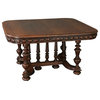
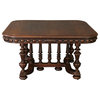
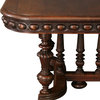
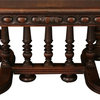
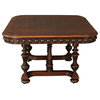
Item 1 of 5







Item 1 of 5


- Product Description
- Product Specifications
- Shipping and Returns
Product Details
- Item #: 16-58D
- Dimensions (inches): 28.25H x 50W x 45D
- Comment: This handsome antique French table from circa 1890 is carved in the Renaissance style, with heavy classical carving decorating the apron, and the fluted legs and stretchers. The dark walnut wood table will look very stately in your home, and is direct imported from Europe. This superb antique French table measures 28 inches high, 50 inches wide, and 45 inches deep.
- Origin: France
- Date: 1890
- Material: Walnut
- Availability: Available for Immediate Shipment.
- Condition
- Condition: GOOD
- In overall good condition. Antique and vintage items by their very nature show normal wear to finish and miscellaneous scratches, nicks, and dings due to age and use. As we define 'good condition' relative to the stated age of the piece, we would expect to see 'character marks' consistent with that age and could include nicks or dings on a piece of furniture, normal separation at joints in wood due to expansion and contraction over time, minor damage to veneer has been stabilized, most locks functioning, most drawers and doors open or slide easily, some original trim may be missing or has been replaced with genuine period-correct substitutes or new reproductions, and there may be one or more splits in the wood due to age and use. If there has been a break in the marble, it has been repaired and the repair may be visible. There may be minor restoration that is visible. Chairs considered 'good condition' may have professional structural repairs but are considered to be structurally sound. These types of repairs may be visible upon close inspection. Upholstered items may show wear consistent with age and use and may need to be reupholstered. EuroLux Antiques makes no representation regarding the comfort of chairs or useability for the customer's particular application.
- Item Specifics: Shows normal wear to the finish and miscellaneous nicks, dings, and scratches on the surface and sides due to age and use.
- Shipping
- This Item Ships Free within the Contiguous 48 United States and this item will be shipped via Vanline. Vanline shipments generally take between 4-8 business weeks after being picked up by the vanline at the EuroLux Gallery. Delivery times may vary depending on your exact location and the current schedule of our preferred vanline.
Additional Information
- Mark: EuroLux Home
- Style: Renaissance RENAISSANCE REVIVAL: HENRY II AND HUNTING STYLES
- As the middle class rose in status and wealth with the advent of the Industrial Revolution in the 19th century, more people were able to afford furniture. This flattening of society in combination with technological advancements created a surge of furniture production. Improved transportation meant a greater variety of wood was available at lower costs. For the first time, furniture became accessible and affordable to the common man. From the 1830s to the end of the 19th century, furniture makers reached back to earlier historical styles, and reinterpreted them with a great deal of creativity and experimentation. Although machines were used to increase speed and productivity, most of the carvings were still done by hand. Consumers were hungry for large, ornate and heavily carved furniture that would impress their friends and family and show off their newly found wealth. The Renaissance Revival style is marked by massive proportions and heavy, ornate carvings. Most furniture was produced in dark oak and walnut. There are actually several sub-styles that fall under the broader Renaissance Revival style and include the Henry II (Henri II) style, Hunting style, Mechelen style, and Louis XIII style.
- In France, the Renaissance style is often referred to as Henry II (Henri II) style, based on the reign of Henry II (1547 e 1559), although it is surprising that the style was not named for his father, Francis I. Considered to be the great French Renaissance monarch, Francis I (1515 e 1547), a contemporary of Henry VIII in England, was a great supporter of the Arts and the Humanities. Enamored with Italian Renaissance art and architecture, he convinced Leonardo da Vinci and other great Italian artists to move to France and work at his court, decorating his many palaces and chateaux (palaces out in the country rather than in Paris) in the lush Loire Valley. He actively collected artistic works by Raphael, Michelangelo, and Titian, which were the beginning of the magnificent art collection of the French kings on display today in the Louvre in Paris. Decorative hallmarks of the Henry II style include arches, pediments, columns, finials, carved flowers, fruit, scrolls and often references to Greek and Roman mythology, including male and female heads, faces or figures.
- The Hunting style developed as an exotic way to decorate the royal and aristocratic hunting lodges (the chateaux of the Loire Valley). Furniture makers specialized in detailed carvings of winged griffins, liones heads, and trophies of the hunt, including deer, fish, eels, rabbits, birds, and dogs. Lush foliage in the form of leaves and berries were often carved along edges of buffets and on the backs of chairs, while the bases of tables were often carved to represent the beasts of the hunt: dogs, boars, deer, and foxes. 19th century consumers of the Renaissance Revival style were crazy for the massive, heavily carved and ornate Hunting style and many pieces also included intricate stained glass doors in the upper cabinets.
- Object: Table
Consigned Antique French Table Renaissance Style
Product Details
- Item #: 16-58D
- Dimensions (inches): 28.25H x 50W x 45D
- Comment: This handsome antique French table from circa 1890 is carved in the Renaissance style, with heavy classical carving decorating the apron, and the fluted legs and stretchers. The dark walnut wood table will look very stately in your home, and is direct imported from Europe. This superb antique French table measures 28 inches high, 50 inches wide, and 45 inches deep.
- Origin: France
- Date: 1890
- Material: Walnut
- Availability: Available for Immediate Shipment.
- Condition
- Condition: GOOD
- In overall good condition. Antique and vintage items by their very nature show normal wear to finish and miscellaneous scratches, nicks, and dings due to age and use. As we define 'good condition' relative to the stated age of the piece, we would expect to see 'character marks' consistent with that age and could include nicks or dings on a piece of furniture, normal separation at joints in wood due to expansion and contraction over time, minor damage to veneer has been stabilized, most locks functioning, most drawers and doors open or slide easily, some original trim may be missing or has been replaced with genuine period-correct substitutes or new reproductions, and there may be one or more splits in the wood due to age and use. If there has been a break in the marble, it has been repaired and the repair may be visible. There may be minor restoration that is visible. Chairs considered 'good condition' may have professional structural repairs but are considered to be structurally sound. These types of repairs may be visible upon close inspection. Upholstered items may show wear consistent with age and use and may need to be reupholstered. EuroLux Antiques makes no representation regarding the comfort of chairs or useability for the customer's particular application.
- Item Specifics: Shows normal wear to the finish and miscellaneous nicks, dings, and scratches on the surface and sides due to age and use.
- Shipping
- This Item Ships Free within the Contiguous 48 United States and this item will be shipped via Vanline. Vanline shipments generally take between 4-8 business weeks after being picked up by the vanline at the EuroLux Gallery. Delivery times may vary depending on your exact location and the current schedule of our preferred vanline.
Additional Information
- Mark: EuroLux Home
- Style: Renaissance RENAISSANCE REVIVAL: HENRY II AND HUNTING STYLES
- As the middle class rose in status and wealth with the advent of the Industrial Revolution in the 19th century, more people were able to afford furniture. This flattening of society in combination with technological advancements created a surge of furniture production. Improved transportation meant a greater variety of wood was available at lower costs. For the first time, furniture became accessible and affordable to the common man. From the 1830s to the end of the 19th century, furniture makers reached back to earlier historical styles, and reinterpreted them with a great deal of creativity and experimentation. Although machines were used to increase speed and productivity, most of the carvings were still done by hand. Consumers were hungry for large, ornate and heavily carved furniture that would impress their friends and family and show off their newly found wealth. The Renaissance Revival style is marked by massive proportions and heavy, ornate carvings. Most furniture was produced in dark oak and walnut. There are actually several sub-styles that fall under the broader Renaissance Revival style and include the Henry II (Henri II) style, Hunting style, Mechelen style, and Louis XIII style.
- In France, the Renaissance style is often referred to as Henry II (Henri II) style, based on the reign of Henry II (1547 e 1559), although it is surprising that the style was not named for his father, Francis I. Considered to be the great French Renaissance monarch, Francis I (1515 e 1547), a contemporary of Henry VIII in England, was a great supporter of the Arts and the Humanities. Enamored with Italian Renaissance art and architecture, he convinced Leonardo da Vinci and other great Italian artists to move to France and work at his court, decorating his many palaces and chateaux (palaces out in the country rather than in Paris) in the lush Loire Valley. He actively collected artistic works by Raphael, Michelangelo, and Titian, which were the beginning of the magnificent art collection of the French kings on display today in the Louvre in Paris. Decorative hallmarks of the Henry II style include arches, pediments, columns, finials, carved flowers, fruit, scrolls and often references to Greek and Roman mythology, including male and female heads, faces or figures.
- The Hunting style developed as an exotic way to decorate the royal and aristocratic hunting lodges (the chateaux of the Loire Valley). Furniture makers specialized in detailed carvings of winged griffins, liones heads, and trophies of the hunt, including deer, fish, eels, rabbits, birds, and dogs. Lush foliage in the form of leaves and berries were often carved along edges of buffets and on the backs of chairs, while the bases of tables were often carved to represent the beasts of the hunt: dogs, boars, deer, and foxes. 19th century consumers of the Renaissance Revival style were crazy for the massive, heavily carved and ornate Hunting style and many pieces also included intricate stained glass doors in the upper cabinets.
- Object: Table
- Product ID
- 12653315
- Sold By
- hproduct
- Size
- W 50" / D 45" / H 28.25"
- Materials
- Walnut
- Category
- Dining Tables
- Style
- Traditional
- Product Description
- Product Specifications
- Shipping and Returns
Product Details
- Item #: 16-58D
- Dimensions (inches): 28.25H x 50W x 45D
- Comment: This handsome antique French table from circa 1890 is carved in the Renaissance style, with heavy classical carving decorating the apron, and the fluted legs and stretchers. The dark walnut wood table will look very stately in your home, and is direct imported from Europe. This superb antique French table measures 28 inches high, 50 inches wide, and 45 inches deep.
- Origin: France
- Date: 1890
- Material: Walnut
- Availability: Available for Immediate Shipment.
- Condition
- Condition: GOOD
- In overall good condition. Antique and vintage items by their very nature show normal wear to finish and miscellaneous scratches, nicks, and dings due to age and use. As we define 'good condition' relative to the stated age of the piece, we would expect to see 'character marks' consistent with that age and could include nicks or dings on a piece of furniture, normal separation at joints in wood due to expansion and contraction over time, minor damage to veneer has been stabilized, most locks functioning, most drawers and doors open or slide easily, some original trim may be missing or has been replaced with genuine period-correct substitutes or new reproductions, and there may be one or more splits in the wood due to age and use. If there has been a break in the marble, it has been repaired and the repair may be visible. There may be minor restoration that is visible. Chairs considered 'good condition' may have professional structural repairs but are considered to be structurally sound. These types of repairs may be visible upon close inspection. Upholstered items may show wear consistent with age and use and may need to be reupholstered. EuroLux Antiques makes no representation regarding the comfort of chairs or useability for the customer's particular application.
- Item Specifics: Shows normal wear to the finish and miscellaneous nicks, dings, and scratches on the surface and sides due to age and use.
- Shipping
- This Item Ships Free within the Contiguous 48 United States and this item will be shipped via Vanline. Vanline shipments generally take between 4-8 business weeks after being picked up by the vanline at the EuroLux Gallery. Delivery times may vary depending on your exact location and the current schedule of our preferred vanline.
Additional Information
- Mark: EuroLux Home
- Style: Renaissance RENAISSANCE REVIVAL: HENRY II AND HUNTING STYLES
- As the middle class rose in status and wealth with the advent of the Industrial Revolution in the 19th century, more people were able to afford furniture. This flattening of society in combination with technological advancements created a surge of furniture production. Improved transportation meant a greater variety of wood was available at lower costs. For the first time, furniture became accessible and affordable to the common man. From the 1830s to the end of the 19th century, furniture makers reached back to earlier historical styles, and reinterpreted them with a great deal of creativity and experimentation. Although machines were used to increase speed and productivity, most of the carvings were still done by hand. Consumers were hungry for large, ornate and heavily carved furniture that would impress their friends and family and show off their newly found wealth. The Renaissance Revival style is marked by massive proportions and heavy, ornate carvings. Most furniture was produced in dark oak and walnut. There are actually several sub-styles that fall under the broader Renaissance Revival style and include the Henry II (Henri II) style, Hunting style, Mechelen style, and Louis XIII style.
- In France, the Renaissance style is often referred to as Henry II (Henri II) style, based on the reign of Henry II (1547 e 1559), although it is surprising that the style was not named for his father, Francis I. Considered to be the great French Renaissance monarch, Francis I (1515 e 1547), a contemporary of Henry VIII in England, was a great supporter of the Arts and the Humanities. Enamored with Italian Renaissance art and architecture, he convinced Leonardo da Vinci and other great Italian artists to move to France and work at his court, decorating his many palaces and chateaux (palaces out in the country rather than in Paris) in the lush Loire Valley. He actively collected artistic works by Raphael, Michelangelo, and Titian, which were the beginning of the magnificent art collection of the French kings on display today in the Louvre in Paris. Decorative hallmarks of the Henry II style include arches, pediments, columns, finials, carved flowers, fruit, scrolls and often references to Greek and Roman mythology, including male and female heads, faces or figures.
- The Hunting style developed as an exotic way to decorate the royal and aristocratic hunting lodges (the chateaux of the Loire Valley). Furniture makers specialized in detailed carvings of winged griffins, liones heads, and trophies of the hunt, including deer, fish, eels, rabbits, birds, and dogs. Lush foliage in the form of leaves and berries were often carved along edges of buffets and on the backs of chairs, while the bases of tables were often carved to represent the beasts of the hunt: dogs, boars, deer, and foxes. 19th century consumers of the Renaissance Revival style were crazy for the massive, heavily carved and ornate Hunting style and many pieces also included intricate stained glass doors in the upper cabinets.
- Object: Table
At Houzz we want you to shop for Consigned Antique French Table Renaissance Style with confidence. You can read real customer reviews for this or any other product and even ask questions and get answers from us or straight from the brand. When you buy Consigned Antique French Table Renaissance Style or any product product online from us, you become part of the Houzz family and can expect exceptional customer service every step of the way. If you have questions about or any other product for sale, our customer service team is eager to help.
Browse over 25 million home design photos on Houzz







